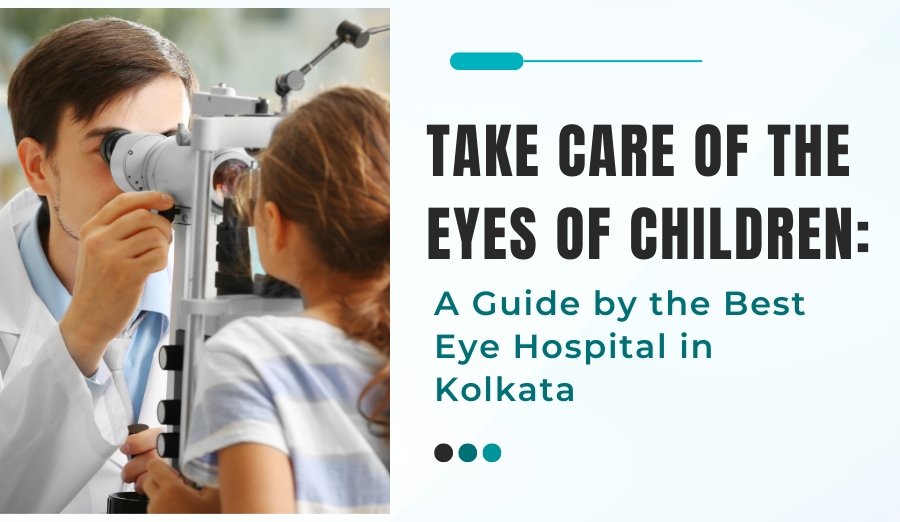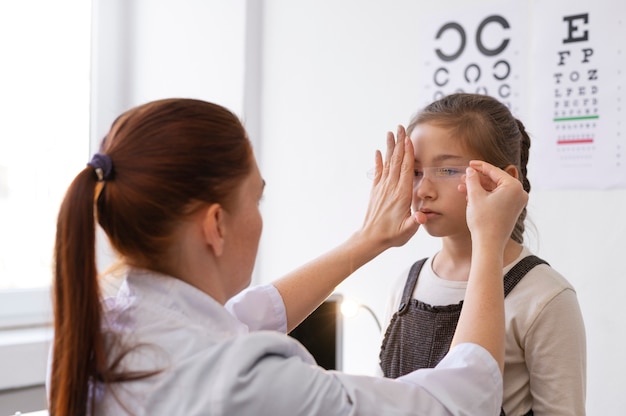Pushpanjali Eye Care, Golpark, Kolkata-700029
Pushpanjali Eye Care, Golpark, Kolkata-700029

By PushpanjaliEyeCare
06.09.2024
Hello Reader!
Welcome to the blog page of Pushpanjali Eye Care, the best eye hospital in Kolkata.
As parents, ensuring your child’s overall health and well-being is a top priority, including eye health. Children rely heavily on their vision to learn and grow, making proper eye care essential from an early age. Pushpanjali Eye Care Hospital, the best eye care center in Kolkata, offers a comprehensive guide on how to take care of your child’s eyes to help prevent vision problems and ensure their optimal development.

The first and foremost step in caring for your child’s eyes is to schedule regular eye check-ups. Eye problems in children often go unnoticed as they may not be able to articulate their symptoms clearly. At Pushpanjali Eye Care, we recommend the first comprehensive eye exam at 6 months, another at age 3, and annual check-ups after that. Regular visits to the best ophthalmology center in Kolkata help in the early detection of common childhood eye issues such as nearsightedness, farsightedness, astigmatism, and even more serious conditions like amblyopia (lazy eye) or strabismus (crossed eyes). Pediatric Ophthalmology is needed for children for treat chronic eye disease, infection.
A nutritious diet is crucial for maintaining good eye health. Foods rich in vitamins A, C, E, and zinc, as well as omega-3 fatty acids, are particularly beneficial for the eyes. Include green leafy vegetables, carrots, oranges, berries, fish, and nuts in your child’s daily diet. These foods help in the development of healthy vision and prevent eye-related conditions. At the best eye hospital in Kolkata, we stress the importance of a balanced diet in maintaining children’s eye health.

Educating children on good eye habits can go a long way in protecting their vision. Here are some habits you can develop in your child if you are serious to take care of your child’s eye:

In today’s digital age, screen time has become inevitable, but it needs to be controlled to protect children’s eye health. Prolonged screen exposure can lead to digital eye strain, causing symptoms like dry eyes, headaches, and blurred vision. Pushpanjali Eye Care, the best eye care treatment center in Kolkata, recommends the 20-20-20 rule: every 20 minutes, take a 20-second break and look at something 20 feet away. This simple exercise relaxes the eye muscles and reduces strain. Pediatric ophthalmology is required specially eye disorder of children.
Children are more vulnerable to UV rays, which can cause eye damage over time. Ensure that your child wears sunglasses that block 100% UVA and UVB rays when outdoors. A wide-brimmed hat can also provide extra protection. At the best eye hospital in Kolkata, we emphasize the importance of UV protection for children’s eyes, especially in sunny weather.

Maintaining good hygiene is vital for preventing eye infections. Teach children to wash their hands before touching their eyes and avoid sharing towels, pillowcases, or handkerchiefs. Additionally, ensure that they wear protective eyewear while playing sports or engaging in activities that could pose a risk to their eyes, such as swimming or cycling. An eye specialist for children always take care of visual system and different kinds of treatment of child eye.
As a parent, being vigilant about your child’s eye health is crucial. Watch out for warning signs such as frequent eye rubbing, squinting, excessive tearing, sensitivity to light, or difficulty reading the board at school. If you notice any of these symptoms, consult an eye specialist immediately. The best eye care center in Kolkata, Pushpanjali Eye Care, is equipped with advanced diagnostic tools and experienced specialists to provide the best care for your child’s eyes.

Spending time outdoors has been shown to reduce the risk of developing myopia (nearsightedness) in children. Encourage your child to play outside for at least an hour a day. Natural light and focusing on distant objects help in the healthy development of the eyes.
Staying informed about your child’s eye health is essential. Regular consultations with eye care specialists at Pushpanjali Eye Care, the best eye hospital in Kolkata, will keep you updated on the latest recommendations for children’s eye care. Being involved in your child’s eye health journey is the best way to ensure they maintain clear and healthy vision.
Also Read: Are There Any Dietary Changes That Can Help with Digital Eye Strains?

Common eye problems in children can significantly affect their vision and overall development. Awareness of these issues and preventive measures can help mitigate their impact.
To prevent eye problems in children, consider the following strategies:

To promote eye health in children, consider the following dietary changes:

Children’s eye health is crucial for their overall development, and regular eye exams play a significant role in ensuring they have the visual skills necessary for learning and interacting with their environment. The frequency of eye exams for children varies based on their age and specific needs. Here’s a breakdown of how often children should get their eyes checked:
Regular eye exams are essential because children often do not recognize or communicate vision problems. Early detection of issues such as refractive errors, amblyopia (lazy eye), or strabismus (crossed eyes) can lead to more effective treatment and prevent long-term vision problems. Research indicates that up to 10% of preschoolers and 25% of school-age children may have vision disorders, making routine check-ups vital.
Taking care of children’s eyes involves a combination of regular check-ups, proper nutrition, good habits, and protective measures. As the best ophthalmology centre in Golpark, Kolkata Pushpanjali is committed to helping parents safeguard their children’s vision. We offer comprehensive eye care services tailored to children’s unique needs, ensuring that they grow up with healthy eyes and clear vision.
If you have concerns about your child’s eye health or want to schedule an eye check-up, visit Pushpanjali Eye Care, the best eye hospital in Kolkata. Our expert ophthalmologists in Kolkata are here to take care of your child’s eye health.

Children should have their first comprehensive eye exam at around 6 months old, another at age 3, and then annually or as recommended by an eye specialist. Regular check-ups are crucial for detecting any vision problems early. Doctors emphasize the importance of early and consistent eye examinations to ensure healthy vision development in children.
A balanced diet rich in vitamins A, C, E, and omega-3 fatty acids is essential for maintaining healthy eyes. Foods like carrots, spinach, oranges, berries, fish, and nuts help improve vision and prevent eye-related conditions. Encouraging children to consume these nutritious foods supports overall eye health and development.
Excessive screen time can lead to digital eye strain, causing symptoms like dry eyes, headaches, and blurred vision. To prevent this, limit screen time and encourage breaks using the 20-20-20 rule: every 20 minutes, look at something 20 feet away for 20 seconds. Expert advises parents to monitor screen usage and encourage outdoor activities to help reduce eye strain.
Signs such as frequent eye rubbing, squinting, excessive tearing, sensitivity to light, or difficulty seeing the board in school may indicate vision issues. If you notice any of these symptoms, consult an eye specialist immediately. Early detection is key to preventing more severe problems, and Pushpanjali Eye Care offers expert diagnosis and treatment for children’s eye conditions.
Children’s eyes are more sensitive to UV rays, which can cause damage over time. Protect their eyes by ensuring they wear sunglasses with 100% UVA and UVB protection when outdoors. Additionally, a wide-brimmed hat can offer extra protection from the sun.